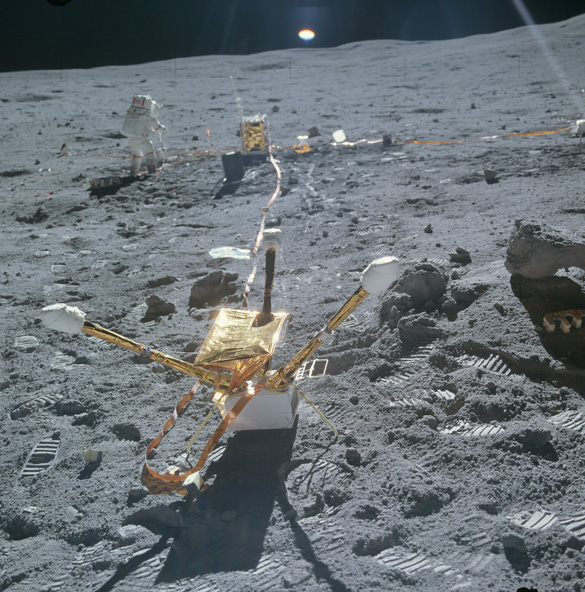
Apollo Guide
Apollo 15 Landing Site

A tri-axis fluxgate magnetometer measured the variations of the magnetic field
of the Moon with time. Because the magnetic field of the Moon can change in
amplitude, frequency, and direction, the magnetometer measures the field in
three directions with sensors located on the end of three small booms. The
electronics were contained in a box at the base of the three booms. It could
measure magnetic flux in nanoTeslas (nT) in three ranges with a resolution of
0.2 nT:
Magnetic fields of the Earth and Moon have two parts; one that changes with time, and one that is steady. The part that changes with time is caused by travelling electromagnetic waves. The steady part of the Earth’s magnetic field, which affects the common compass, varies from 35,000nT at the equator to 60,000nT at the poles, whereas the lunar magnetic field is only about 6 to 100 nT gamma, most likely due to the presence of natural magnetism in lunar rocks inherited early in the Moon’s history, when the magnetic field was much stronger that it is today. The Lunar Orbiters data inferred there was a steady magnetic field of about 8 nT. The magnetometer also measured the variation in time of the magnetic field, caused by electromagnetic waves propagated from the Sun.
The seismic information, magnetometer, and heat flow experiments contributed the principal information about the Moon’s interior. It is now believed the Moon’s crust is multi-layered and 50 kilometers thick, with a secondary boundary occurring about 20 kilometers under the surface. The upper mantle has been determined to consist of olivine or olivine-pyroxene matter, and to be quite homogeneous, extending about 500 kilometers down. Below this level the seismic data infers the interior is iron-enriched, although there is insufficient data to determine if the Moon has a molten core.

Non - Normal
Contingent EVA 2 - One Man , Two Hours
Description and Rationale
A second contingent EVA timeline is presented for a situation where only one crewman will egress .* The use of this EVA timeline , as for the other contingent timeline , will require a real time decision . All of the reasons , or even if one would be cons idered in real time , have not yet been determined . One reason might be the failure of one PLSS to check out . Another might be a LM subsystem malfunction which required continuous monitoring . Other suppos itions could require a decision to conduct a one man EVA.
As for Contingent EVA 1, it is assumed that the CDR can egress . However , if this is not possible , each crewman should be capable of accomplishing the other crewman 's tasks .
For this contingent situation the crewman on the surface should be able to accomplish most of the nominal activities within two hours . He may , however , require verbal assistance from the other crewman as well as more time to perform the tasks which he nominally does not perform.
* The Final Flight Mission Rules for Apollo 11 will govern the selection of the crewman to egress and the EVA he will accomplish.






|
|
The Apollo Spacecraft Intelligent Manual Panoramic Edition: Interactive Guide of the First SPacecraft to Bring Humanity to the Moon Kindle Edition |
Home / Acronyms / Index / Schematics / Systems
Operations / Non-Normal / Normal
Panels / 1 / 2 / 3 / 4 / 5 / 6 / 8 / 12 /14
Copyright 2021 APOLLO 11 GUIDE©